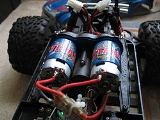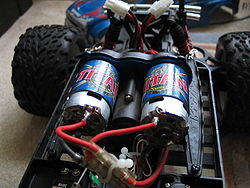
Internal fan-cooled electric motor
Encyclopedia
An internal fan-cooled electric motor (colloquially, fan-cooled motor) is a self cooling electric motor
. Fan cooled motors feature an axial fan
attached to the rotor
of the motor (usually on the opposite end as the output shaft) that spins with the motor, providing increased airflow to the motor's internal and external parts which aids in cooling.

s
in applications with poor airflow because heat sink
s usually require air to be flowing over them for maximum effectiveness. Internal fan cooling also takes up far less space than external fan cooling
or water cooling.
on their power source. Also, like any device with a fan
, increased airflow through the motor can cause increased dust build up, which could potentially hinder the motor's operation.
Electric motor
An electric motor converts electrical energy into mechanical energy.Most electric motors operate through the interaction of magnetic fields and current-carrying conductors to generate force...
. Fan cooled motors feature an axial fan
Fan (mechanical)
A mechanical fan is a machine used to create flow within a fluid, typically a gas such as air.A fan consists of a rotating arrangement of vanes or blades which act on the air. Usually, it is contained within some form of housing or case. This may direct the airflow or increase safety by preventing...
attached to the rotor
Rotor (electric)
The rotor is the non-stationary part of a rotary electric motor, electric generator or alternator, which rotates because the wires and magnetic field of the motor are arranged so that a torque is developed about the rotor's axis. In some designs, the rotor can act to serve as the motor's armature,...
of the motor (usually on the opposite end as the output shaft) that spins with the motor, providing increased airflow to the motor's internal and external parts which aids in cooling.

Uses
Fan cooled motors have many common uses in motors that either produce a lot of heat or have poor airflow because they are always stationary or in an enclosed space and require a compact cooling system. They are common for industrial uses, household appliances such as blenders and mixers, power tools such as drills and rotary tools, and radio-controlled carRadio-controlled car
Radio-controlled cars are self-powered model cars or trucks that can be controlled from a distance using a specialized transmitter...
s
Advantages
Attaching an internal fan to a motor is a fairly simple way to cool it. Since a fan cooled motor always provides airflow over itself regardless of whether it is stationary or partially enclosed, it is more effective than using a heat sinkHeat sink
A heat sink is a term for a component or assembly that transfers heat generated within a solid material to a fluid medium, such as air or a liquid. Examples of heat sinks are the heat exchangers used in refrigeration and air conditioning systems and the radiator in a car...
in applications with poor airflow because heat sink
Heat sink
A heat sink is a term for a component or assembly that transfers heat generated within a solid material to a fluid medium, such as air or a liquid. Examples of heat sinks are the heat exchangers used in refrigeration and air conditioning systems and the radiator in a car...
s usually require air to be flowing over them for maximum effectiveness. Internal fan cooling also takes up far less space than external fan cooling
TEFC
TEFC stands for Totally Enclosed, Fan-Cooled and refers to an industrial electric motor equipped with an external fan to circulate outside air to the motor.Compare to ODP -References:*...
or water cooling.
Disadvantages
All fans generate noise, something that may not be desired in a motor, and dragDrag (physics)
In fluid dynamics, drag refers to forces which act on a solid object in the direction of the relative fluid flow velocity...
on their power source. Also, like any device with a fan
Fan (mechanical)
A mechanical fan is a machine used to create flow within a fluid, typically a gas such as air.A fan consists of a rotating arrangement of vanes or blades which act on the air. Usually, it is contained within some form of housing or case. This may direct the airflow or increase safety by preventing...
, increased airflow through the motor can cause increased dust build up, which could potentially hinder the motor's operation.

